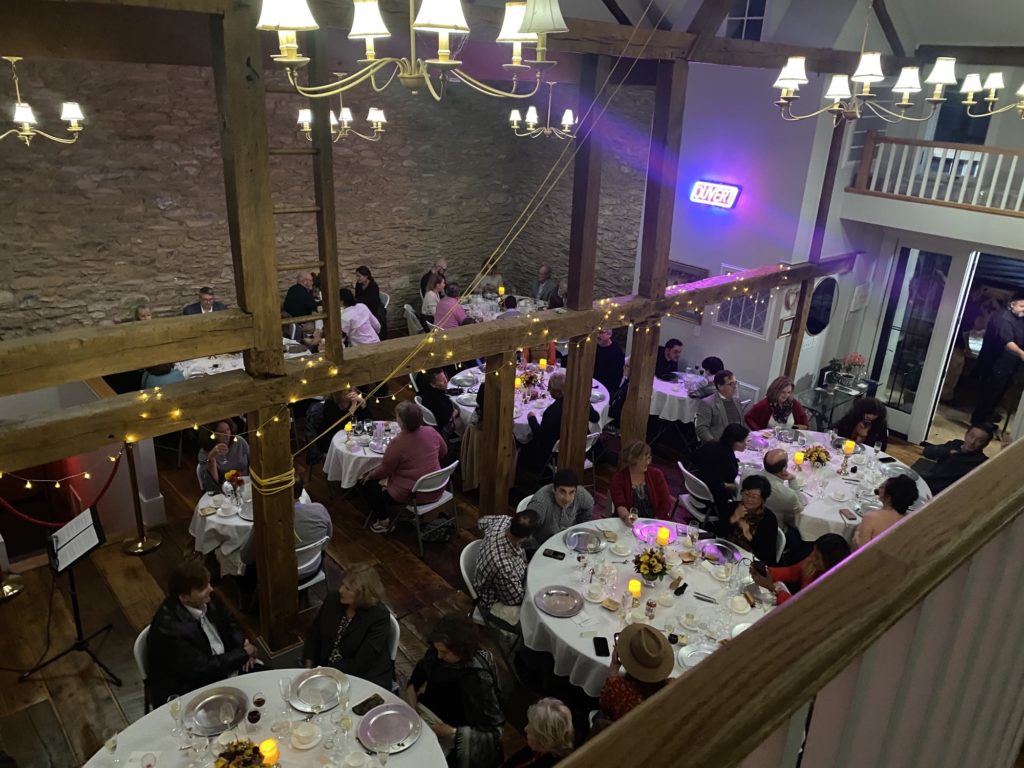A Taste of Gascogne
A Taste of Gascogne
August 12, 2023 6:00 pm
$150 per person
ALL ABOARD! The last stop of the Culinary Tour of France at Shiloh Manor Farm arrives in Gascogne in southwestern France.
 Like Provence, Gascogne – or Gascony – is laden with bucolic symbolism, one of those regions of southern France whose name evokes images of warmth and sunshine, and a traditional, rural way of life far removed from the hassle and stress of the modern world. The name sounds like Tuscany, and indeed the two regions, one in France, the other in Italy, have much in common. But unlike Tuscany, or the Loire Valley, Gascony has yet to become a popular destination for bucket-listers seeking grand chateaus, opulent palaces, and soaring basilicas. The region’s treasures are often tucked out of sight, as if waiting to be discovered. In the city of Auch is the Tour d‘Armagnac – a 14th-century prison – with its amazing statue of d’Artagnan, the famous but fictitious leader of the Three Musketeers.
Like Provence, Gascogne – or Gascony – is laden with bucolic symbolism, one of those regions of southern France whose name evokes images of warmth and sunshine, and a traditional, rural way of life far removed from the hassle and stress of the modern world. The name sounds like Tuscany, and indeed the two regions, one in France, the other in Italy, have much in common. But unlike Tuscany, or the Loire Valley, Gascony has yet to become a popular destination for bucket-listers seeking grand chateaus, opulent palaces, and soaring basilicas. The region’s treasures are often tucked out of sight, as if waiting to be discovered. In the city of Auch is the Tour d‘Armagnac – a 14th-century prison – with its amazing statue of d’Artagnan, the famous but fictitious leader of the Three Musketeers. 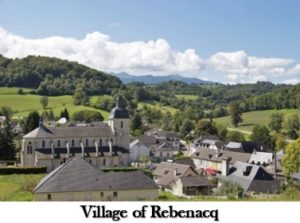 A little further south in Pau, is the magnificent Chateau of Henri IV, with its panoramic view of the snowcapped Pyrenees. On a clear day you can see a sharp cleft in the mountains called Pic du Midi, where legend has it that the mortally wounded Roland slashed at the mountain with his sword Durendal in a failed effort to break it so it would not fall into the hands of the invading Saracens. Countless small villages dot the Garonne valley and the foothills of the Pyrenees with names like Leberrere, Juillacq and Nay. Rebenacq – a village of a few hundred people, deep into a remote Pyrenean valley, is where my great grandmother was born and at least 10 generations of my ancestors lived and farmed. Even the first time I braved the narrow, winding and poorly marked roads to get there I felt strangely at home.
A little further south in Pau, is the magnificent Chateau of Henri IV, with its panoramic view of the snowcapped Pyrenees. On a clear day you can see a sharp cleft in the mountains called Pic du Midi, where legend has it that the mortally wounded Roland slashed at the mountain with his sword Durendal in a failed effort to break it so it would not fall into the hands of the invading Saracens. Countless small villages dot the Garonne valley and the foothills of the Pyrenees with names like Leberrere, Juillacq and Nay. Rebenacq – a village of a few hundred people, deep into a remote Pyrenean valley, is where my great grandmother was born and at least 10 generations of my ancestors lived and farmed. Even the first time I braved the narrow, winding and poorly marked roads to get there I felt strangely at home.
Encompassing the region from Bordeaux to Bayonne along the Atlantic coast, as far east as Toulouse near Provence, with the dramatic Pyrenees mountains along the southern border to Spain, Caesar called this region Gallia Aquitania after the then dominant Aquitani people. The region was renamed Novempopularnia (that is, “land of the nine tribes”) by Diocletian in the third century. Nature abhors a vacuum, and after the Roman empire collapsed under the weight of its own excesses in 476 AD, Novempopulania was invaded by waves of Germanic tribes, most notably the Vandals and Visigoths.
If the history of Europe teaches us anything it is that peace is short and elusive. The Visigoths were defeated by the Franks in 507, and Novempopulania became part of the Frankish Kingdom of Clovis. However, after the death of Charlemagne the Frankish empire fragmented, and the region was taken by the Vascones. According to Roman geographers such as Pliny the Elder and Livy, the Vascones were an ancient, pre-Indo-European group of peoples who spoke an archaic version of what is today the Basque language. Both the English word “Basque” and “Gascon” are derived from the root “Vascones.”
But more than a rich history and spectacular scenery, there is no other region of France quite as renowned for its authentic locally sourced food as Gascogne. For this the last stop in our Culinary Tour of France at Shiloh Manor Farm, Chef Erik and I have developed a menu that makes it easy to understand why the French say even the poorest peasant in Gascogne eats like a king!
We begin with Amuse-Bouche of Foie Gras and Salmon Canapés. Gascogne is renowned for its Foie Gras and is the largest producer of it in the world. Yet few realize that Foie Gras has a history much older than Gascogne or even Roman Gaul. It was the ancient Egyptians that first realized that waterfowl feeding on the Nile would gouge themselves before long migrations and store those extra calories in their liver. Soon the Egyptians discovered that feeding a duck or goose would produce a large liver that could be processed into a rich paté. The Greeks passed it on to the Romans who carried this knowledge into Gaul in the first century.
Our menu includes goose or “Foie Gras d’Oie,” which is more subtle and refined than the more common duck Foie Gras. While many might not think of salmon in France, the many rivers that flow from the Pyrenean snowcaps provide excellent salmon fishing. Our menu includes fresh wild caught salmon canapés drizzled with herb seasoned grapeseed oil.
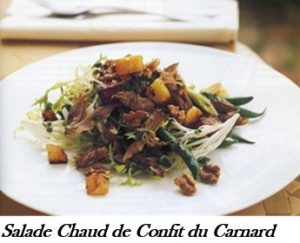 Hors d‘œuvres consists of your choice of a Salade Chaud de Confit du Carnard or Bisque de l’Écrevisse. Like Foie Gras, Confit du Canard is one of the pillars of Gascon cuisine! Salade de Confit du Canard features a classically prepared potted duck, deep fried, crispy, and boneless, sliced and served warm over a bed of mixed Shiloh Farm greens with a walnut oil vinaigrette. Bisque de l’Écrevisse is a delicious crawfish bisque. Many of the fast-moving rivers in Gascogne have crawfish and they are a unique part of the local cuisine. The first time I tried this delicious soup was in the village of Ste Jean Pied du Port. In our authentic recipe, the shell is stuffed with a crawfish mousse. We are pairing the hors d’oeuvres with a fine rosé from Domaine Guy Mousset.
Hors d‘œuvres consists of your choice of a Salade Chaud de Confit du Carnard or Bisque de l’Écrevisse. Like Foie Gras, Confit du Canard is one of the pillars of Gascon cuisine! Salade de Confit du Canard features a classically prepared potted duck, deep fried, crispy, and boneless, sliced and served warm over a bed of mixed Shiloh Farm greens with a walnut oil vinaigrette. Bisque de l’Écrevisse is a delicious crawfish bisque. Many of the fast-moving rivers in Gascogne have crawfish and they are a unique part of the local cuisine. The first time I tried this delicious soup was in the village of Ste Jean Pied du Port. In our authentic recipe, the shell is stuffed with a crawfish mousse. We are pairing the hors d’oeuvres with a fine rosé from Domaine Guy Mousset.
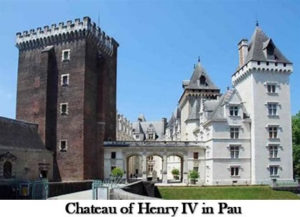 For the Entrée we are offering your choice of Poule au Pot or Le Gigot d’Agneau. Poule au Pot (literally “chicken in a pot” ) is long associated with “Good King Henri IV,” a native of Pau. To end the famine caused by the devastating 16th century civil war between French Huguenots and Catholics, Henri declared,
For the Entrée we are offering your choice of Poule au Pot or Le Gigot d’Agneau. Poule au Pot (literally “chicken in a pot” ) is long associated with “Good King Henri IV,” a native of Pau. To end the famine caused by the devastating 16th century civil war between French Huguenots and Catholics, Henri declared,
“If God grants me life, I will see that every laboring man in my Kingdom shall have his chicken to put in the pot for Sunday dinner.”
Restaurants in Pau and throughout Béarn still serve Poule au Pot to celebrate the birthday of Good King Henri IV on December 13th.
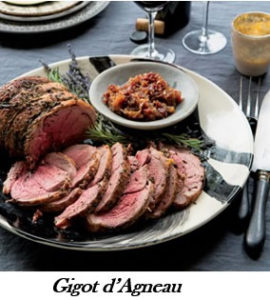 Le Gigot d’Agneau – roast leg of lamb – is a classic French comfort food! It is born out of the old village custom in days before home ovens were commonplace , when people would bring their roasts to the local baker to place in his slowly cooling ovens after the days bread was done. Le Gigot d’Agneau is served with fresh summer vegetables, including Oignon Montesquieu – savory pearl onions in a sweet and sour sauce. Both entrées are paired with a fine Médoc Cru Bourgeois Supérieur from Chateau Pierre de Montignac.
Le Gigot d’Agneau – roast leg of lamb – is a classic French comfort food! It is born out of the old village custom in days before home ovens were commonplace , when people would bring their roasts to the local baker to place in his slowly cooling ovens after the days bread was done. Le Gigot d’Agneau is served with fresh summer vegetables, including Oignon Montesquieu – savory pearl onions in a sweet and sour sauce. Both entrées are paired with a fine Médoc Cru Bourgeois Supérieur from Chateau Pierre de Montignac.
Any traditional French meal always has a separate cheese course. For our Plat du Fromage we are offering three classic cheeses from the southwest of France: Ossau-Iraty, Pic de Cabasse and Rocamadour.
During the “transhumance”, cows, sheep, and goats are led up the mountain paths to reach their summer grazing on the slopes of the imposing Pyrenees. Because of its short growing season, the pastures on the mountain slopes are lush and flowery, giving a subtle hint of licorice and wild thyme to the cheeses! Animals are typically milked by hand in the field. The cheeses are traditionally made in simple shepherds’ huts, also located on the slopes, without electricity, using methods that haven’t changed much in thousands of years.
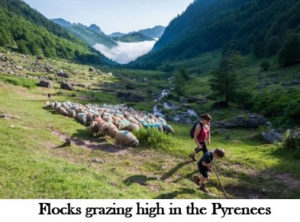 “Ossau-Iraty” is made from a blend of milk from sheep grazing in the valleys of Ossau in Béarn and Iraty, in the Basque Country. Two countries, two pastoral traditions that come together to give this cheese with a unique flavor and texture that has been appreciated for hundreds of years. The “Pic de Cabasse” – produced in the village of Ariège – is a cow’s milk cheese. And Rocamadour is a traditional Pyrenean goat cheese, prized for its nutty, fresh, and creamy flavor. We are pairing the cheese course with a fine sparkling rosé from Domain Figuerie.
“Ossau-Iraty” is made from a blend of milk from sheep grazing in the valleys of Ossau in Béarn and Iraty, in the Basque Country. Two countries, two pastoral traditions that come together to give this cheese with a unique flavor and texture that has been appreciated for hundreds of years. The “Pic de Cabasse” – produced in the village of Ariège – is a cow’s milk cheese. And Rocamadour is a traditional Pyrenean goat cheese, prized for its nutty, fresh, and creamy flavor. We are pairing the cheese course with a fine sparkling rosé from Domain Figuerie.
Lastly, for dessert we are serving the Gascogne classic Cannelé. Believed to have originated in the Convent of Annonciades in Bordeaux in the 1400’s, Cannelé is a small pastry made with cognac and vanilla with a soft custard center and a thick, crisp, and caramelized crust. It is a multi-day process to make Cannelé requiring specialized copper molds seasoned with beeswax (from our own apiary). With coffee and tea, Cannelé is the perfect ending of a perfect Gascogne meal!
A bientôt!
Nick Donnangelo
The Culinary Tour of France at Shiloh Manor Farm
A Taste of Gascogne

